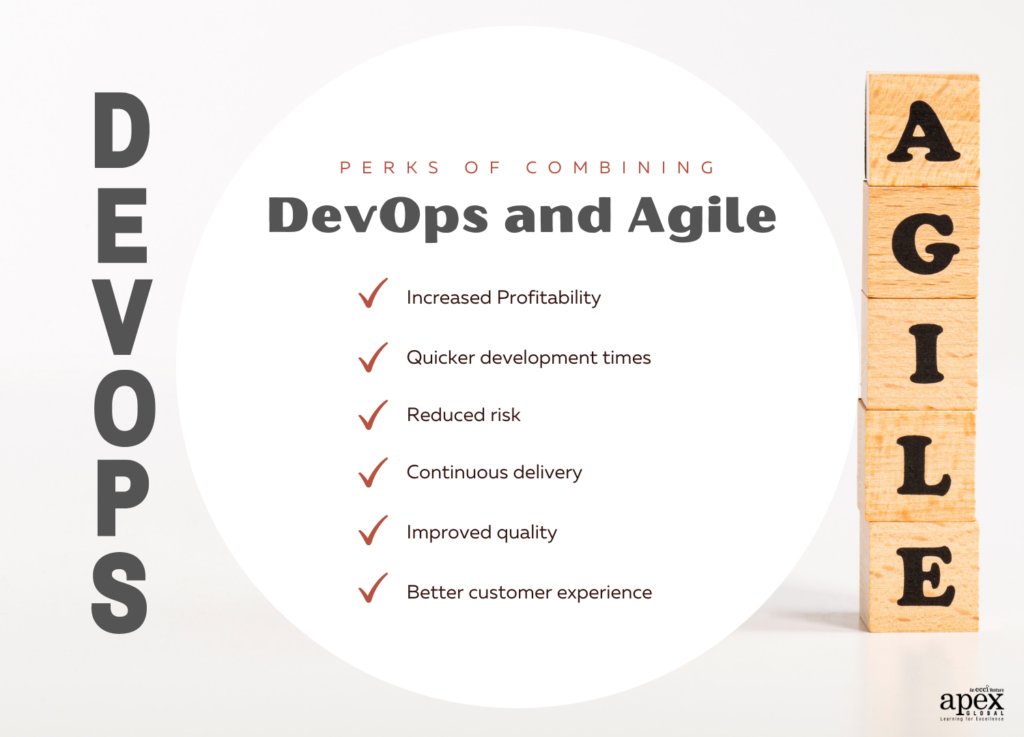Businesses today are under constant pressure to deliver new features and products faster than ever before. In order to meet these demands, many organizations are turning to Agile and DevOps methodologies. Despite their growing popularity, there are still some misconceptions about Agile and DevOps, in their adoption and approach.
In this blog post, we’ll dispel some of the most common myths about Agile and DevOps. So, if you’re considering these approaches for your organization, read on!
What you'll find in this article [hide]
- 1 Dispeling 7 Myths About Agile and DevOps
- 1.1 Myth #1: Agile and DevOps are the same thing.
- 1.2 Myth #2: Agile is only for software development teams.
- 1.3 Myth #3: DevOps is only for large organizations.
- 1.4 Myth #4: Agile means no planning or documentation.
- 1.5 Myth #6: Agile is only for small projects.
- 1.6 Myth #7: You cannot change course once you start using Agile or DevOps.
- 2 Agile and DevOps for Continuous Quality Improvement
- 3 Tips When Implementing DevOps and Agile
- 4 Conclusion
Dispeling 7 Myths About Agile and DevOps
Myth #1: Agile and DevOps are the same thing.
One of the most common misconceptions about Agile and DevOps, are that the two approaches share some common elements.
Agile is a methodology that emphasizes iterative development, constant feedback, and tight integration between developers and stakeholders. DevOps is a set of practices that helps to automate the software delivery process, promote communication and collaboration between teams, and enable faster delivery of high-quality software.
While both Agile and DevOps share a focus on speed and collaboration, they are not the same thing. Agile is a methodology for developing software, while DevOps is a set of tools and practices for delivering software. Agile provides a framework for developers to follow, while DevOps helps organizations to streamline their software delivery process. As a result, Agile and DevOps are complementary approaches that you can use together to improve the efficiency of software development.
Removing the table as it contains contradictory claims and it’s too technical for us to stick to one school of thought.
Myth #2: Agile is only for software development teams.
Agile is not only for software development teams. Many other types of organizations are using Agile methods to increase employee satisfaction and productivity. Agile has been shown to improve communication and collaboration within teams. It also helps to create a more adaptable and flexible workplace.
In addition, Agile can help reduce costs and shorten project timelines. This makes it more popular in a variety of industries. Whether you’re developing software or managing a hotel, Agile may be the right choice for your organization.

Myth #3: DevOps is only for large organizations.
While DevOps was originally developed for large organizations, it is now being adopted by small and medium-sized businesses as well. This is due to the fact that DevOps can help to improve the efficiency of any organization, regardless of size. DevOps helps to automate the software delivery process, which can save time and money

Moreover, DevOps promotes communication and collaboration between teams, which can improve efficiency. This makes DevOps a good choice for any organization that wants to improve its software delivery process.
Myth #4: Agile means no planning or documentation.
Agile is often thought of as a “no-planning” approach to software development, but that’s not entirely accurate. To avoid pitfalls that come with Agile implementation, your enterprise needs to have executive support and buy-in from key stakeholders. While Agile teams do not spend a lot of time upfront generating detailed documentation, they do need to have a clear understanding of what they’re trying to achieve. In Agile terms, this is “product backlog.”
The product backlog is a prioritized list of features or requirements that the team plans to implement. It is typically maintained by the product owner (a role that may be filled by the business sponsor, product manager, or even the development team itself). As work is completed, the product backlog is updated to reflect the current state of the product.
Agile teams also generate documentation during the course of their work, but they focus on creating just enough documentation to capture what they’ve done and why. This approach is known as “evolutionary documentation.” By keeping documentation to a minimum, Agile teams can avoid the downsides of traditional documentation-heavy approaches, such as scope creep and the requirement for constant updates.
Myth #5: DevOps means no testing or quality assurance.
Another one of the common misconceptions about Agile and DevOps is that DevOps, in particular, does not need for testing or quality assurance. While DevOps does emphasize automation, this does not mean that testing and quality assurance are not important. In fact, both are still essential in a DevOps environment; they just need to be done in a more automated way.
For example, rather than having a separate team of testers, DevOps teams typically integrate testing into their continuous integration and continuous delivery pipelines. This allows them to detect and fix errors more quickly, which can improve the quality of the software.
Myth #6: Agile is only for small projects.
While Agile was originally developed for small, software development projects, it is now being used on larger projects as well. In fact, many organizations are using a hybrid of Agile and traditional project management approaches to deliver large, complex projects. This hybrid approach combines the best aspects of both Agile and traditional approaches, such as consolidated documentation, formalized processes, and clear roles and responsibilities. As a result, hybrid Agile is becoming increasingly popular for managing large projects.
Myth #7: You cannot change course once you start using Agile or DevOps.
Of all the misconceptions about Agile and DevOps, the most persistent belief is that once you start using DevOps and Agile, you can never go back to traditional methods. This is simply not true.
DevOps and Agile are flexible frameworks that you can adapt to your organization’s specific needs. If your organization decides to change course, there is no need to throw out your DevOps or Agile practices entirely. Instead, you can simply adapt them to fit your new goals. By understanding the flexibility of DevOps and Agile, you can overcome any obstacle in your path.
Agile and DevOps for Continuous Quality Improvement

As mentioned earlier, DevOps is all about automating and streamlining the software development process, from design to deployment. By automating repetitive tasks and increasing communication and collaboration between teams, DevOps can help to speed up the delivery of new features and improve software quality.
Agile is a popular methodology for implementing DevOps, as it places an emphasis on incremental development and rapid feedback loops. By combining DevOps with Agile, organizations can continuously deliver high-quality software at a rapid pace. It can be a way to improve a business over time.
Moreover, DevOps, can help in other aspects of business too. For example, it can help to improve communication between teams, reduce errors, and increase transparency. All of these benefits can lead to a better customer experience and increased profitability.
Tips When Implementing DevOps and Agile
To help you start off with DevOps and Agile, here are some tips you should keep in mind:
Do your research.
Before you implement them in your business or organization, it’s important to do your research and understand what these concepts entail. Make sure you understand the basics of Agile methodology and DevOps culture. This will help you tailor your implementation to fit your specific needs.
Define your goals.
What are you hoping to achieve by implementing DevOps or Agile? Make sure you have a clear idea of your goals before you even start, as this will help you to make the right decisions along the way.
Start small.
If you’re just starting out with DevOps or Agile, it’s best to start small. Implement these concepts in one area of your business or organization first, then expand from there. This will allow you to gradually introduce change and give everyone time to adjust. Aim to maintain a healthy work-life balance even while growing with DevOps and Agile.
Choose the right tools.
There are a wide variety of DevOps and Agile tools available, so it’s important to choose the ones that are right for your business or organization. Consider your needs and budget when making your decision.
Train your employees.
Your employees will need training on how to use the new tools and processes that you’re implementing. Make sure you allocate enough time and resources to training so that everyone is up to speed.
Monitor progress.
Once you’ve implemented DevOps or Agile, it’s important to monitor progress and make sure that it’s achieving the desired results. Regularly review your goals and objectives to ensure that you’re on track.
Be flexible.
DevOps and Agile are all about being flexible and adaptable, so make sure you are ready to change course if necessary. If something isn’t working as planned, don’t be afraid to try something different.
Be prepared for change.
When you implement DevOps or Agile, you’re likely to see some changes in your organization. Be prepared for this change and embrace it. Encourage your team to be open to new ideas and ways of working. This will help the transition go smoothly.
Seek feedback.
Make sure you seek feedback from employees, especially from your data engineers, developers, and ops team, to get their thoughts on the implementation of DevOps or Agile. This feedback can help you to make improvements and ensure that your implementation is successful.
Ask for help when needed.
Don’t hesitate to seek help from outside sources if you need it. There are a lot of people who have been through this process before and can offer valuable advice and guidance. Reach out to your network or hire a consultant if you need assistance.
Conclusion
There are a lot of misconceptions about Agile and DevOps out there – but hopefully, this blog post has helped clear some things up! These two approaches can be extremely helpful for businesses that are looking for ways to speed up their delivery times without sacrificing quality or customer satisfaction levels.
Also, we hope that the tips we have shared will be helpful as you start to implement Agile and DevOps within your own organization. Remember, there’s no one-size-fits-all solution – so take the time to tailor your implementation to fit your specific needs. And don’t forget to seek feedback along the way so that you can make improvements where necessary.
Good luck!
Katie Pierce is a teacher-slash-writer who loves writing mainly about business growth opportunities. She also loves telling stories, whether it’s to bored adults in front of a computer screen or a bunch of hyperactive 4-year-olds. Writing keeps her sane (most of the time) and allows her to enjoy some quiet time in the evening before she walks into a room of screaming kids (all of whom she loves dearly) the next morning.


